Treat yourself to this super-moist, delicate, and bouncy Japanese sponge cake with a hint of honey! Made with only four ingredients, Castella Cake is a very popular tea-time confection in Japan that makes the perfect holiday or hostess gift, too.
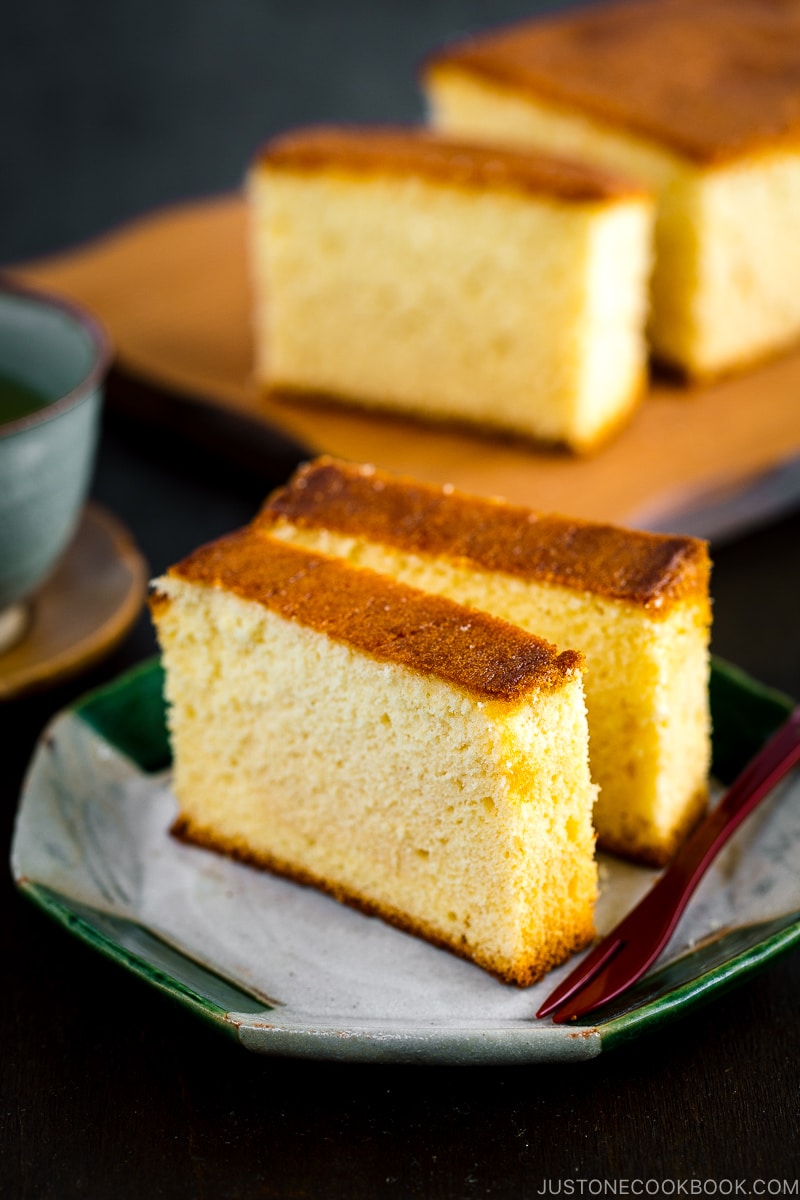
Japanese Castella Cake, or Kasutera (カステラ) in Japanese, is a popular Japanese honey sponge cake that Portuguese merchants originally introduced to the Nagasaki area in the 16th century. The name derives from the Portuguese Pão de Castela, meaning “bread from Castile”. To make Castella, we use just 4 basic ingredients: bread flour, eggs, sugar, and honey.
A dark brown top and bottom crusts with a creamy yellow center give a beautiful contrast to the sponge cake. This delicate cake is very moist, smooth, bouncy, and has just enough sweetness with a fragrance of honey.
The difference between Japanese honey sponge cake and regular western sponge cake is that Japanese Castella is more delicate and bouncy in texture. It is raised solely by egg foam. There is no butter, oil, or any leavening agent like salt or baking powder. It also uses bread flour (higher gluten content) instead of regular flour to achieve the result. The flavor is very light with mild sweetness. Therefore the cake is delightful to enjoy green tea or iced coffee during summertime.
You can tell by its popularity as Castella is being sold everywhere in Japan, from departmental stores, and specialty sweet stores to convenience stores. They often come in a slim rectangle box in simple plastic packaging for an everyday snack or fanciful packaging for gifting.
Traditionally, Japanese Castella cake is baked slowly in a wooden frame to create a soft smooth texture for the sponge. A metal baking pan would transfer the heat too fast and it would become too dry. I assume most of you would not have a wooden frame readily available, so my Castella recipe uses a standard 1-lb loaf pan.
I searched for Castella recipes in Japanese and found hundreds of recipes available online. The majority of them use just the same 4 ingredients with slightly different measurements for each recipe. I started to experiment with measurements for each ingredient for my 1-lb loaf pan. Then I increased to two pans as my family really loves this light and moist Japanese Castella Cake for oyatsu (snack).
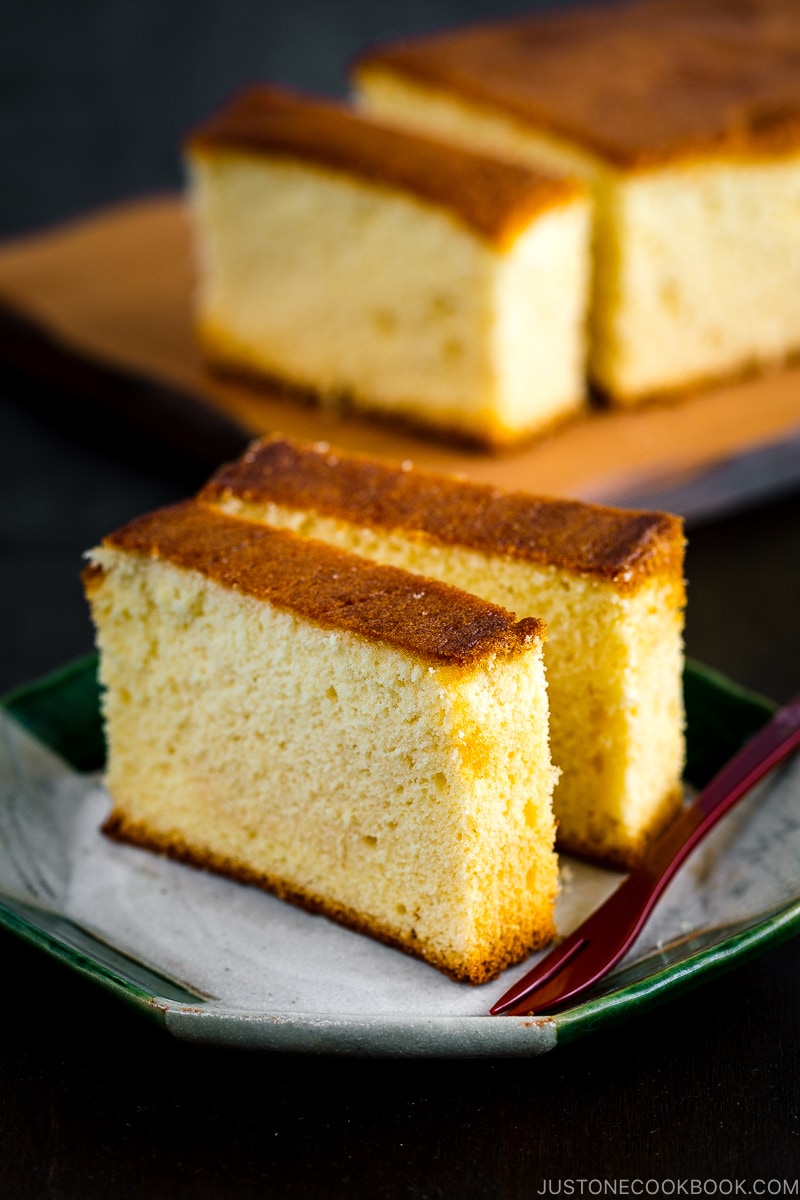
Before I move on to the recipe, I want to mention that it took me a very long time to finalize this recipe. Since then, I have been using this exact recipe many times and it worked each time. However, please understand that everyone’s oven works differently and you may need to adjust the recipe according to your oven.
Japanese Castella Cake Baking Notes:
The key to a successful Castella is in the beating of the eggs and baking time. Even after trying many times, I still wish to improve the slightly wrinkled top (Any tips, anyone?). Otherwise, the texture and flavor is just perfect!
Before I realized that I needed to create my own recipe that works for my oven, I had tried many other Castella recipes I found online. However, I failed miserably despite the beautiful pictures shared in those recipes. Here are some of the tips I learned from my experience in achieving the perfect texture:
Failure 1: A hard and dense layer formed at the bottom of the cake although the top layer turned out beautifully.
Tips:
- There needs to be enough air beaten into the batter for the cake to rise. Make sure to beat the eggs based on the time specified. The texture will be thick and the color will be pale yellow. When you stop the mixer and lift the whisk attachment, the mixture should fall into ribbons.
- Sift the flour two times to loosen.
Failure 2: The cake sank in the middle during the baking, or after I pulled it out from the oven.
Tips:
- Bake it longer until the cake is firm and fully cooked inside.
- Do not over-mix the batter when you add the flour mixture.
- Must use bread flour.
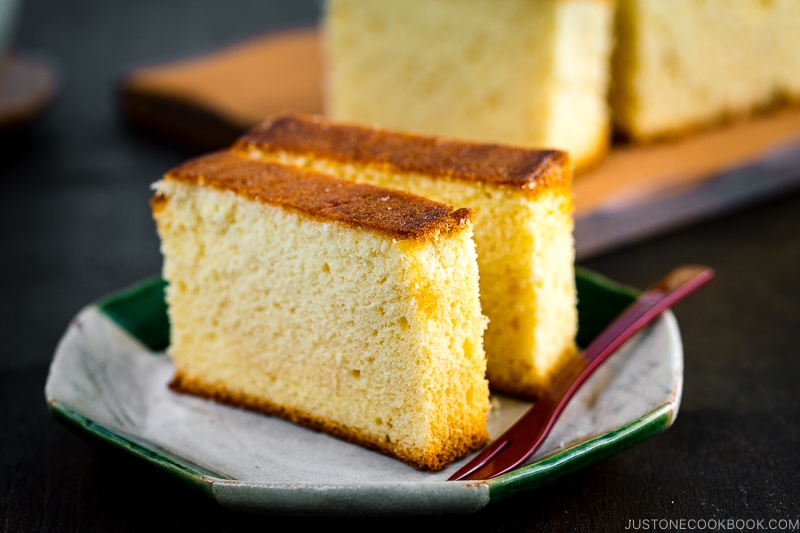
A lot of recipes suggested to bake at a higher temperature and covering the cake with aluminum foil to prevent the cake from browning further and finish baking. However, this made the cake start to sink immediately and it didn’t work for me… Therefore, I couldn’t bake at a higher temperature than 320 ºF (160 ºC).
Some recipes suggest baking it at a higher temperature to brown the top first, then changing to a lower temperature to continue baking. But being unable to cover the top with aluminum foil, my only option was to bake at 320 ºF (160 ºC) and slowly brown the top without overcooking inside of the cake.
You may need to tweak my recipe in order to get the perfect result. I have also seen some recipes that require extra steps and ingredients, but I made this recipe as simple as possible without losing authentic flavor. I hope my recipe works for you and you will get to enjoy Castella with your family and friends.
I’ve also included a 3-minute Japanese Castella Cake recipe video above, so I hope you will check it out.
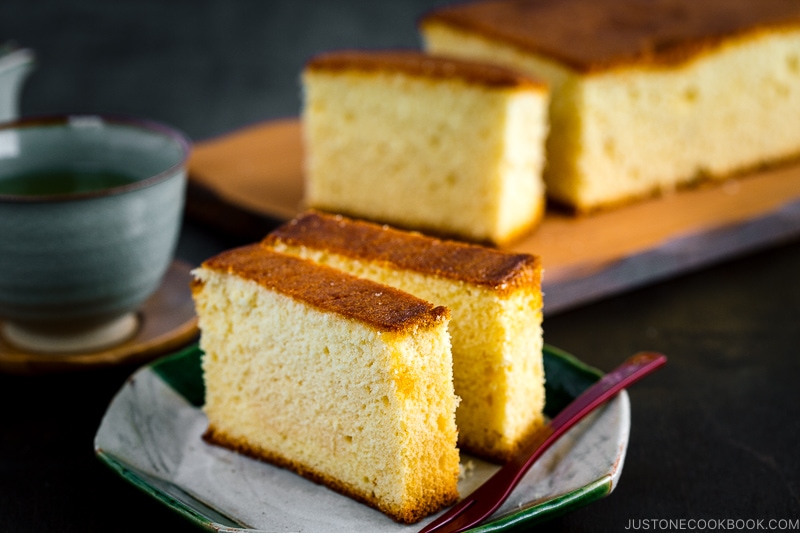
Wish to learn more about Japanese cooking? Sign up for our free newsletter to receive cooking tips & recipe updates! And stay in touch with me on Facebook, Pinterest, YouTube, and Instagram.
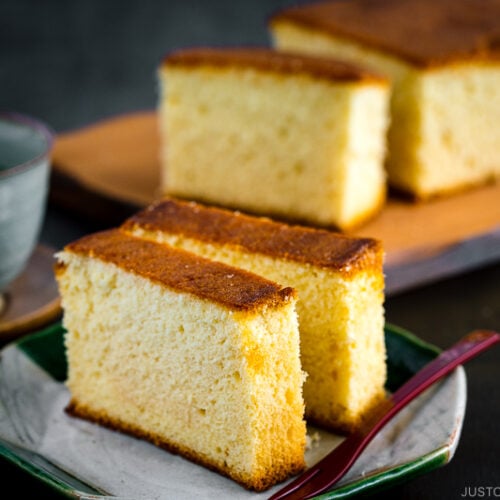
Japanese Castella Cake
Video
Ingredients
- 1⅔ cup bread flour (weigh your flour or use the “fluff and sprinkle“ method and level it off)
- 2½ Tbsp water (warm)
- ⅓ cup honey
- 6 large eggs (50 g each w/o shell) (at room temperature—very important!)
- 1 cup sugar
For the Honey Syrup
- 1 Tbsp honey
- ½ Tbsp water (warm)
Instructions
- Before You Start: Please note that this recipe requires a resting time of 1 day.I highly encourage you to weigh your ingredients using a kitchen scale for this recipe. Click on the “Metric“ button at the top of the recipe to convert the ingredient measurements to metric. If you‘re using a cup measurement, please follow the “fluff and sprinkle“ method: Fluff your flour with a spoon, sprinkle the flour into your measuring cup, and level it off. Otherwise, you may scoop more flour than you need.
- Gather all the ingredients. Preheat the oven to 320ºF (160ºC). For a convection oven, reduce the oven temperature by 25ºF (15ºC) to 295ºF (145ºC).

- Cut the parchment paper to fit the baking pans (see the video for this process). You will need two loaf pans (8½ x 4½ x 2¾ inches, or 22 x 11 x 7 cm). If your pans are smaller, add the excess batter to another smaller pan and use a shorter bake time.

To Make the Batter
- Sift 1⅔ cup bread flour twice with either a sifter or fine-meshed strainer. Holding the handle of the strainer with one hand and tapping it gently with the other, the flour will gradually sift through the strainer. Tip: Bread flour gives the cake an elastic, bouncy texture that you cannot achieve with all-purpose flour.

- Add 2½ Tbsp water to ⅓ cup honey (5 Tbsp + 1 tsp) and whisk well.

- Fit a stand mixer with the whisk attachment. Crack 6 large eggs (50 g each w/o shell) into the bowl of the mixer and vigorously whisk until combined.

- Add 1 cup sugar.

- Beat the eggs and sugar on high speed (Speed 10) for 5 minutes. If you beat the eggs with a handheld mixer, it will take more time. The beaten eggs will quadruple in volume. The texture will be thick and the color will be pale yellow. When you stop the mixer and lift the whisk attachment, the mixture should fall in ribbons.

- Add the honey mixture into the egg mixture and whisk on low speed (Speed 2) until combined, about 30 seconds.

- Add the bread flour in three parts. Add one-third of the bread flour and whisk at low speed (Speed 2) for 15 seconds. Then, add another third and whisk for another 15 seconds. Finally, add the last remaining portion and whisk until just combined for about 1 minute. Do not overmix.

To Bake
- Spray the loaf pans with oil and distribute it evenly with a pastry brush.

- Put the parchment paper in the pans and make sure the paper sticks to the pans. If is does not, apply more oil to the pan, spread it evenly with a brush, and place the parchment paper again.

- Pour the batter into the pans about 80% full.

- Using a skewer, draw a zigzag line through the batter to remove the air bubbles in the batter.

- Level the batter by holding each pan 2 inches above the counter and dropping it flat onto the counter. Do this several times to release the air bubbles.

- Bake at 320ºF (160ºC) in the middle rack of the oven for 35 to 40 minutes (I bake my cakes for 35 minutes), or until golden brown and a skewer inserted in the center comes out clean. Turn off the oven, at which point I open and leave my oven door ajar for a few minutes. Then, I take out the cakes. When done, the cake sides will pull away from the pan slightly; the top will be flat and feel spongy when pressed with a finger.

To Apply the Syrup and Chill Overnight
- To make the honey syrup, mix 1 Tbsp honey and ½ Tbsp water in a bowl. Immediately apply the honey syrup over the tops of the hot cakes with a pastry brush.

- For each cake, place a sheet of plastic wrap on the countertop. Take out the hot cakes from the pan and place them top down on the plastic wrap. Gently peel off the parchment paper.

- Immediately wrap the cakes with the plastic film to retain moisture. Bring the cake to room temperature. Then, put the wrapped cakes in the refrigerator and store them overnight (or at least 12 hours), keeping the top side facing down. This will help the cakes develop a fine and moist texture.

To Serve
- Remove the cake from the refrigerator. Bring the cake to room temperature. Slice off the four sides of the cake with a sharp bread knife. Then, cut the cake into ¾- to 1-inch-thick slices (you will get 7–8 slices total). Serve it with tea or coffee, if you‘d like.

To Store
- To save for later, wrap individual pieces with plastic wrap. You can store at room temperature for up to 3–4 days, 5–7 days in the refrigerator, and 1 month in the freezer.
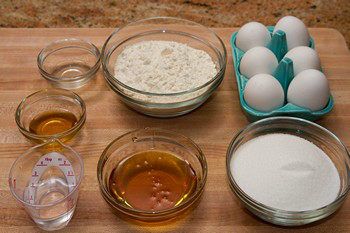
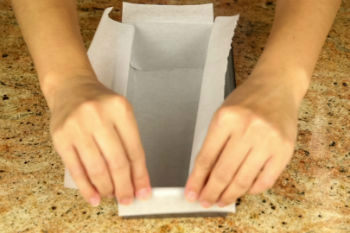
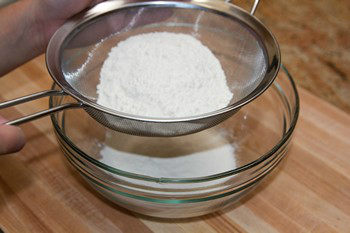

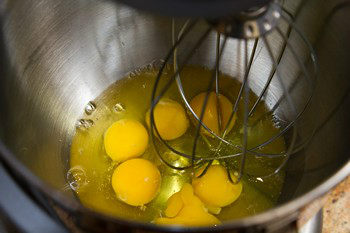
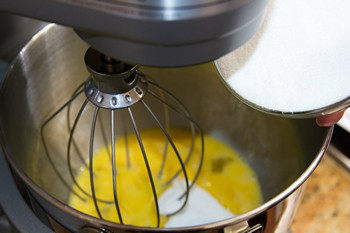

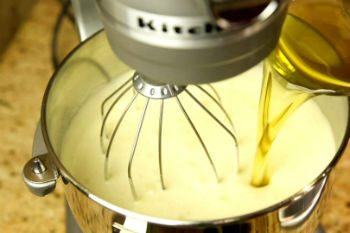


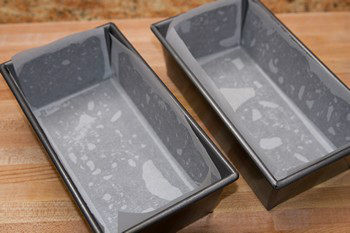
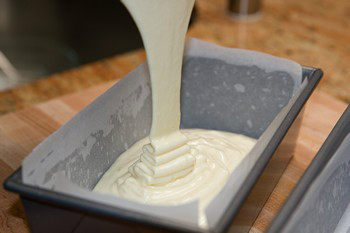
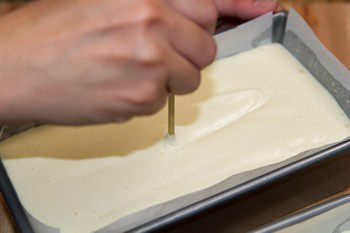
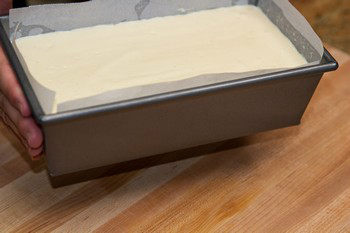
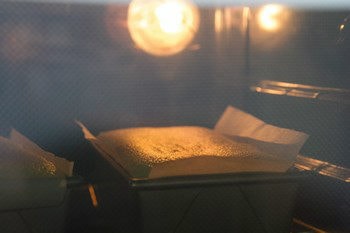


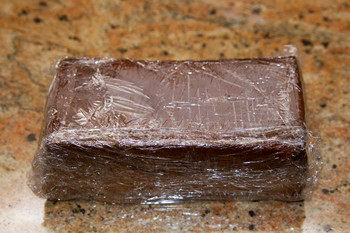
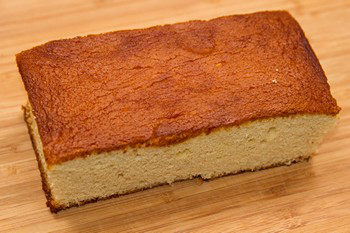










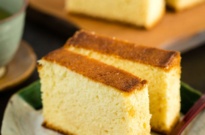
would a gluten-free version of this cake be possible?
Hi lilly, Thank you very much for reading Nami’s post!
We have never used gluten-free bread flour for this recipe, but it might work. Let us know how it goes!
I made it a lot of times. Really good. The third time though, a rubbery layer on the bottom appeared? What went wrong?
Hi Russel! Thank you very much for trying Nami’s recipe and for your kind feedback!
The rubbery texture is usually caused by over mixing the dough after you add the flour. Would you please review Step 9 and see if something went differently?
We hope this helps!
Hi, I tried the recipe out for the first time. It seems to have turned out okay, except the cake didn’t seem to rise sufficiently and was too dense.
Would it help if I separated the egg white and beat that on its own? I’m going to try that next time.
Hi Sam! Thank you very much for trying Nami’s recipe!
There are different ways to make this cake, and separating eggs is one of the ways. If you try it, let us know how it goes!
Can I use whole wheat bread flour in place of regular bread flour?
Hi Caroline! Thank you very much for reading Nami’s post!
The whole wheat flour absorbs more liquid than regular flour, so if you use it in a recipe like this, you need to adjust the amount of the ingredient. Otherwise, the texture of the Cake will be different.
We hope this helps!
How much of an adjustment would you recon?
Hi Caroline! Sorry, We didn’t test the recipe with whole wheat bread flour, and we don’t have the recipe for it.😓 The adjustment would be not just flour amount. It needs to test with different ratios of eggs and water.
Can I cut down on the sugar?
Hi Moon, You can cut down 10% of sugar, but it will have a different texture if you do more than that.
We hope this helps!
How do you eat it?
For example, do Japanese people eat it with sliced fruit topped on it? Is it eaten with milk or hot tea / cold tea / ice tea? If served with tea, is it sweetened or unsweetened? When is it served (after dinner), for breakfast, or as a snack? Is it a special occasion food, such as for a wedding or a birthday?
Coming from a different culture, it’s puzzling to understand how it is served and under what conditions. Though some will say, “You just eat it.” I think that gives injustice to the food. For example, Americans wouldn’t serve pancakes without syrup and coffee, or for dinner. Pancakes aren’t a birthday cake 🎂 or a wedding 👰 dessert, and not eaten with your hands but with a fork and knife.
These cultural ways of eating, I think matters a lot but few websites ever teach how to eat it besides just the recipe. Maybe you can add it to your recipes as a summary for those foreign to Japanese culture. Thank you….
Hi Joanne! Thank you very much for reading Nami’s post!
We serve this cake on a plate with a fork in Japan, just like Nami’s photo in this post. And it often enjoys the cake as snacks.
This post was published in 2013, and at the time of blogging, the style was different from now. When Nami revisits this post, we will make sure to add more information. Thank you for your suggestion.🙂
This recipe is amazing!!! it was so good our family finished it within 2 days XD
I’ve made this multiple times, the first time I made it there were wrinkles too 😂
I am not sure if its coincidence or not, but when I heated the eggs/sugar up using a bain-marie until it reached 35º-40º before beating it, the cake ended up with no wrinkles after baking.
Also I find that baking it at 170ºC at first for 10 minutes and then at 160ºC for around 30minutes produces better results but maybe it’s just my oven (I don’t have an oven thermometer)
Hi Cameron! Awesome! Thank you very much for trying Nami’s recipe and for sharing your baking experiment with us.
We are so happy to hear your family enjoy the Castella Cake. 😁
i want to reduce the sugar to 1/4 cup. will it matter? this is too sweet for me(lemme know asap , this looks delish and i cant wait to try it;)
Hi Sahla, The sugar will bring moisture to the cake, and if you cut back more than 1/4 cup of sugar from this recipe, it will be a dry texture.
You may want to add extra egg yolk if you are reducing the significant amount of sugar. We hope this helps!
I used 1 x 2lb loaf pan instead, what is the bake time?
I baked it at 45mins + 7 mins over door slightly open.
It was abit too dry on the side and the bottom. The top middle part is perfectly done. I really want to perfect this recipe. I love the flavor.
Hi Myrna, Thank you very much for trying Nami’s recipe!
Every oven is different, so we can’t tell the exact baking time for your oven, but you if your cake was too dry on the side and the bottom, we recommend baking shorter time or try an insulating cake pan strip. We hope this helps!
Hello Nami. I love your recipes. Saw that you have matcha and earl grey chiffon cake recipe and was wondering if you it is possible to make earl grey/matcha castella as well?
Hi June, Thanks for your request!
We’ll make sure to add the recipe to Nami’s list.
Hi Nami! Your recipe looks incredibly simple and delicious! (Maybe not that simple haha). Because I don’t have bread flour, I was wondering if white whole wheat flour would be the same thing? I thought I’d ask because you know a lot more! Thanks again!
Hi Dean, Thank you very much for trying Nami’s recipe!
White whole wheat flour and bread flour are different, and The white whole wheat flour won’t rise quite as high as bread flour, and the cake’s texture won’t be the same. We hope you can try this recipe with bread flour. Happy Baking!
Hi Nami! Thank you for your hard work and for sharing this recipe – I really appreciate the meticulous instructions! After reading the comments, I decided to bake it in a water bath. It took a little longer to bake, around 15-20 minutes. I think having the loaf pans in the water bath made it more difficult for the heat to get to the bottom of the cake so I took it out of the water for the last 5 minutes to make sure it set as I didn’t want the top to brown too much. The cake turned out great! The next day, it still had its lovely smooth top 🙂 I’m excited to make this with different flavors and to try the water bath again to see if I can get the baking time down. I also replaced a little bit of the water with rosewater and I think I may try to put a little more next time 🙂 Thank you again!
Hi Emily! Thank you very much for trying Nami’s recipe and for your sweet comment to Nami!
We are glad to hear the water bath method made a good result! Thank you for sharing your baking experience with us. Happy Baking!
I just put my first cake in the fridge and judging from looks, feel and smell it turned out pretty good… at least for my first attempt.
The rise was a bit uneven and I suspect that caused some minor cracks… not the end of the world though. I might have to fiddle with the temperature a bit. thoughts on that?
I did use spelt flour since a friend of mine cannot eat wheat-gluten… might be a valid option for some cases of gluten intolerance.
I did cut back on some of the sugar aswell since the honey already made the cake plenty sweet for my taste … might reverse that next time and see what it does to the dough… maybe next week.
I am incredibly tempted to experiment with fruit and other flavours once i get the hang of the cake… I might report back if I ever get there.
Anyways thank you for the recipe. this might be my new “go to” cake from now on since it is rather quick and actually super easy.
Hi Markus, Thank you very much for trying this recipe and sharing your baking experience with us!
The cracked top could be from the higher temperature, but we hope you enjoyed the taste.🙂
Is honey important for the texture and consistency, or can it be omitted or replaced in the batter? We have a family member who cannot eat honey.
So far, my thoughts are to replace it with brown sugar syrup, or maybe vanilla syrup, but I’m worried about the batter not turning out quite right.
Hi Monika! The brown sugar syrup or vanilla syrup may work well for this recipe.
However, the texture will be similar, but the flavor will be different.
We hope this helps! Happy Baking!
Hi Nami, thank you soo much for the recipe. Really appreciate that we all enjoy the benefits of your refinements to the recipe so we don’t have to go through the arduous tasks of trial and error. My Castella cake turned out well (surprisingly) since I’ve not had much luck with baking. It was a little too sweet for me though, so would reduce the sugar the next time. However, I notice the bottom half of the cake was slightly less fluffy than the top. Is that due to the fact that the flour wasn’t mixed well. Also the top did come up golden brown, but i notice it was much darker brown on one side of the top than the other side. Does this mean the heat in my oven is not balanced.
Hi Iris, Thank you very much for trying Nami’s recipe!
When the cake top color is not even, it’s possible that your oven has some hot spot and not distributing the heat evenly. The bottom cake was slightly less fluffy means that it may need to cook a little longer or because your oven has a hot spot, the oven’s internal temperature was not accurate, and it was lower than your settings.
We recommend checking your oven’s internal temperature and adjust the temperature as need it. Some people place a baking stone on the lowest rack to eliminating any hot spots.
We hope this helps and your next try will be a success!
Thank you for your quick response! Will note the tips for the next bake and also get the hot spot issue fixed.
My pleasure! Good Luck!🙂